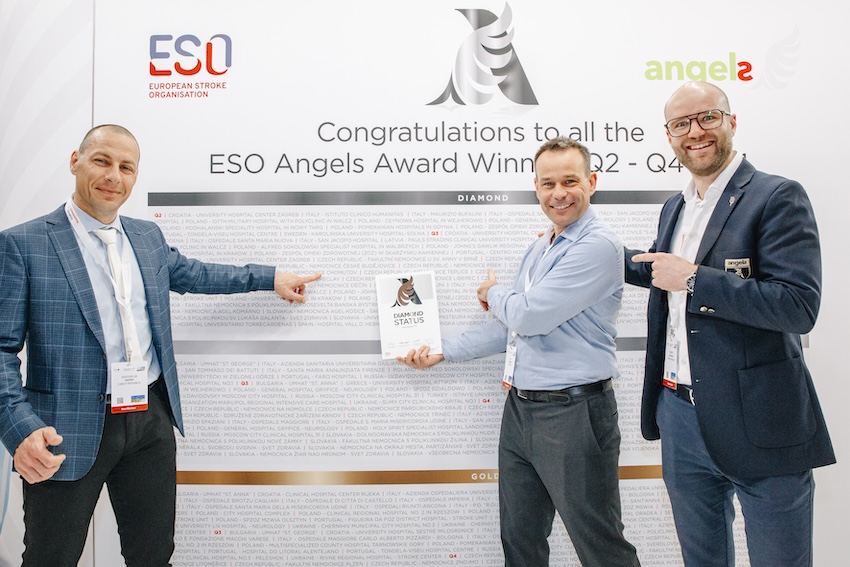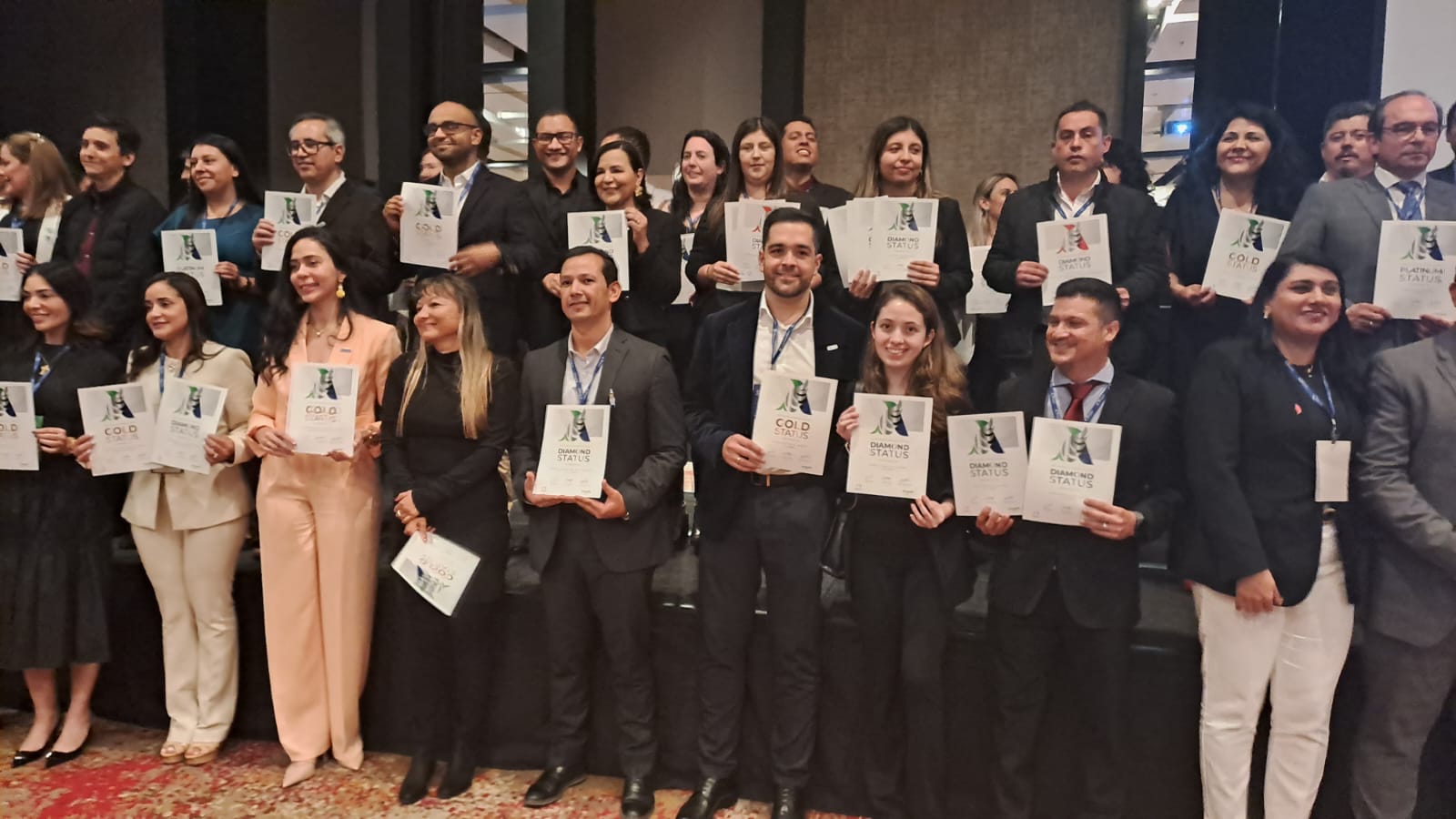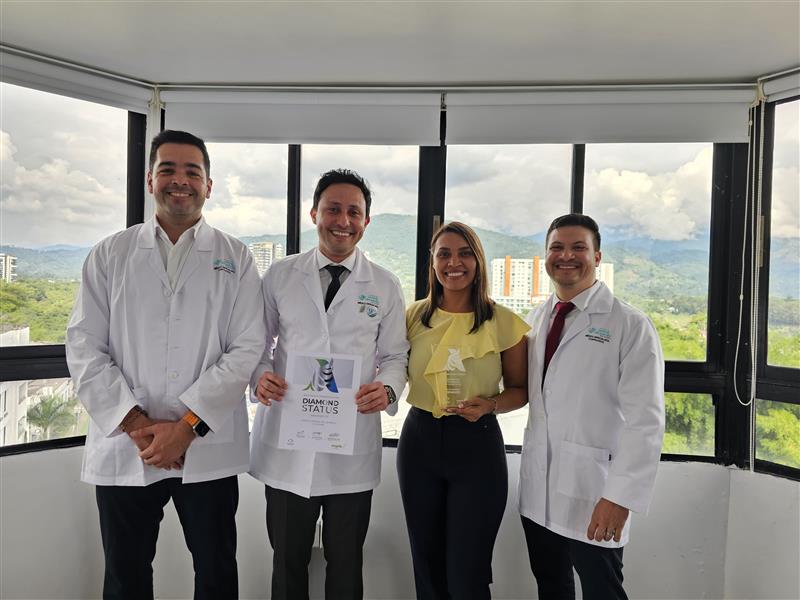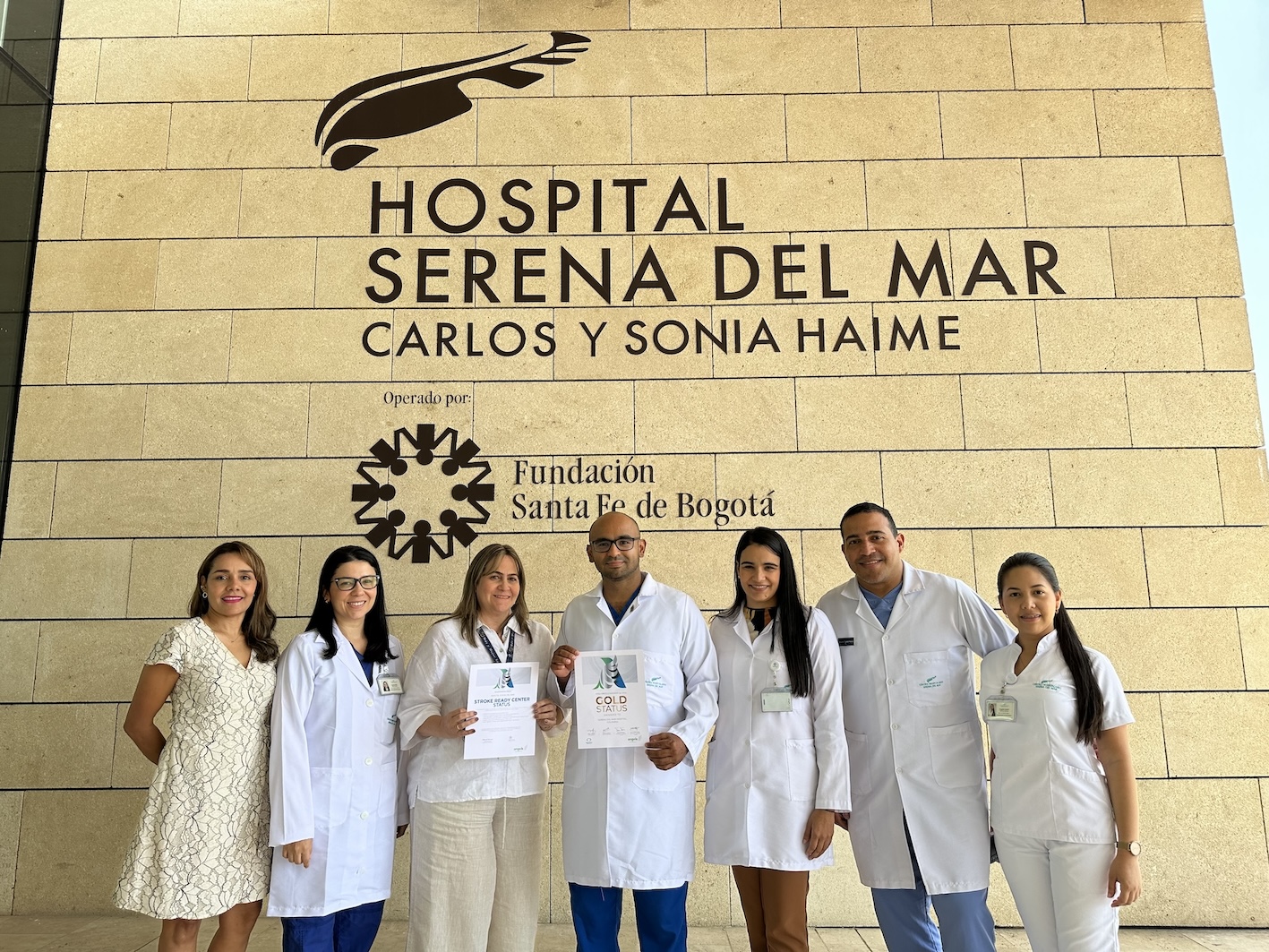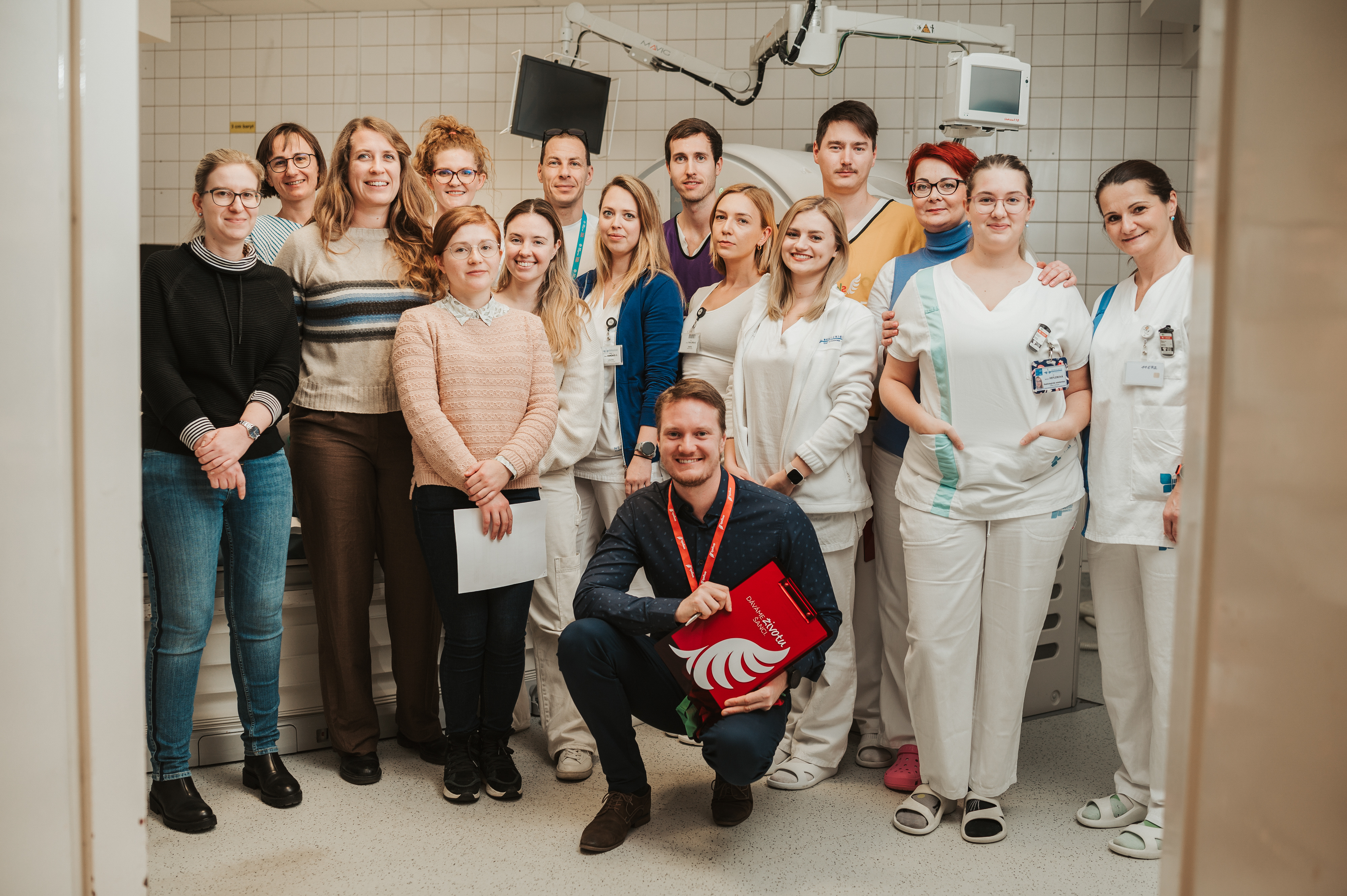
LE mardi 21 novembre 2023, la Dre Caterina Kulyk, neurologue de Linz en Haute Autriche, s'est retrouvée dans une position inhabituelle. Elle jouait le rôle d'un touristique autrichien qui, lors d'une visite à l'hôpital Budkéjovice de la région de la Bohémie Sud de la République Tchèque, avait subi la grande malheur d'avoir un AVC.
Il n'est pas difficile de voir pourquoi un touristique autrichien pourrait mettre Budïjovice à leur itinéraire. Son centre historique bien préservé présente de nombreux exemples d’architecture de Renaissance et de Baroque, ainsi que la plus grande fontaine de la République tchèque, et la ville est célèbre pour sa bière.
"Se trouvant en train de traverser l'entrée d'urgence de l'Hôpital Budkéjovice lors d'un atelier de simulation d'accident vasculaire cérébral, le Dr Kulyk s'est senti désorienté. "Je ne comprenais pas ce qui se passait", explique-t-elle, "et je ne voyais pas où j'étais pris. Même en tant que personne en bonne santé, l’expérience m’a semblé confuse et j’étais très contente lorsque le personnel autour de moi m’a expliqué ce qui se passait et les étapes suivantes.
Ce point de vue du patient est l’un des facteurs ayant influencé les soins neuro-vasculaires au Kepler University Hospital depuis l’exercice de simulation transfrontalière de novembre dernier.
Martin Liptay, consultant chez Angels, explique comment la simulation s’est déroulée :
"Lors de l'ESOC 2023, Robert Havalda (responsable d’équipe Angels) et moi avons été approchés par une neurologue tchèque, le Dr Michaela Schober, qui travaillait à l'époque à l'hôpital Barmherzige Brüder à Linz. Le Dr Schober a demandé si nous pouvions faire une formation de simulation dans sa ville. Parce que nous n'avons pas de consultant là-bas, nous avons pensé qu'il serait une bonne idée d'effectuer une formation de simulation dans le centre complet de Budïjovice, qui est l'un des principaux centres accident vasculaire cérébral en République tchèque, et d'inviter des centres accident vasculaire cérébral de la région de la Haute Autriche à nous rejoindre."
Le Dr Schober avait quitté Linz au moment où l’invitation a été envoyée à cinq hôpitaux autrichiens, dont l’hôpital universitaire Kepler, où le Dr Kulyk, un neurologue italien de Padoue, venait de succéder au Dr Milan Vosko en tant que directeur de l’unité neuro-vasculaire et s’est concentré sur l’amélioration de leur délai d’attente avant l’aiguille.
"Nos temps se sont améliorés", dit-elle, "mais il y avait encore une marge d'amélioration".
"A l'ESOC, nous avions entendu parler de l'excellent délai entre l'arrivée et la perfusion. Nous avons hâte d’échanger des points de vue et d’apprendre de l’expérience de nos collègues, comme nous le faisons en fait dans les régions voisines, en partageant des collines et des vallées. Nous avions aussi entendu dire que le neurologue en chef Dr Svatopluk Ostr à était très bon et très agréable donc c'était une très bonne opportunité".
Trois collègues ont accompagné le Dr Kulyk à South Bohemia, un neurologue qui était nouveau dans le domaine de l’accident vasculaire cérébral et deux résidents, respectivement, au début et à la fin de leur internat. Le trajet de Linz à Budkéjovice a duré moins de deux heures.
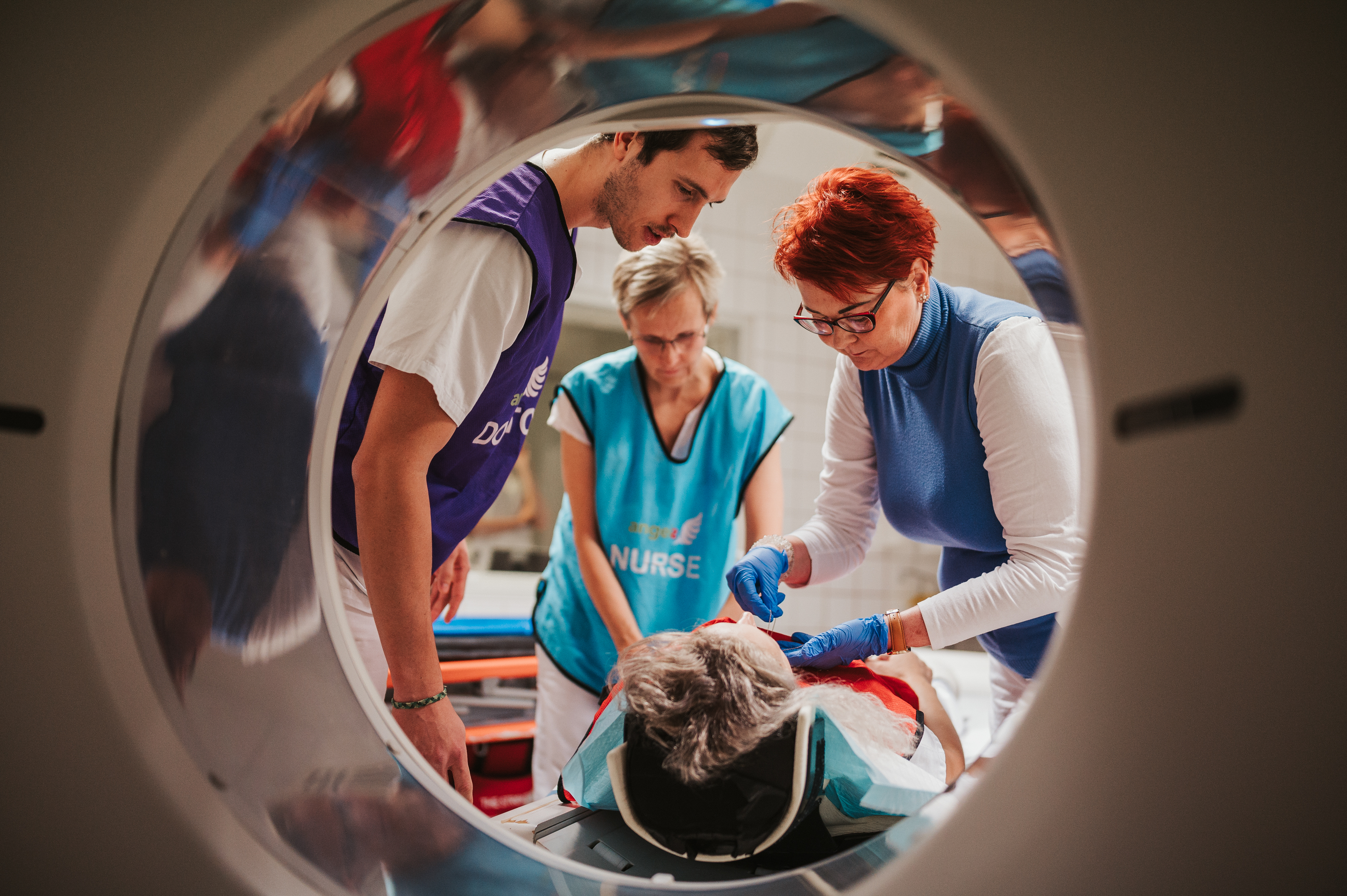
Meilleur, plus rapide, plus sûr
Le très bon et très agréable Dr Svatopluk Ostr est devenu chef de la neurologie à l’hôpital Budkéjovice en 2015, et est arrivé ici en 2012 après 11 ans en tant que neurophysiologiste dans une équipe neurochirurgicale à l’Hôpital militaire central célèbre de Prague. Il avait déménagé en Bohémie du Sud pour changer sa vie professionnelle et personnelle, dit-il. "Ici, il y avait un grand hôpital dans une grande ville, mais pas aussi grande que Prague. Prague était trop grande pour moi, j'avais besoin de quelque chose de plus petit".
Ici aussi, c’était l’occasion de commencer quelque chose de nouveau, pour aborder un autre sujet important qui était néanmoins lié à ses années en neurochirurgie.
"Donc c'était en lien avec le changement de ma vie professionnelle et l'amélioration de ma vie personnelle", dit-il. Dans la poursuite de ces objectifs, il a fait de son hôpital un repère dans les soins neuro-vasculaires, en traitant plus de patients avec une thrombolyse par an que tout autre établissement du pays, avec une durée médiane de DTN comprise entre 15 et 18 minutes, en réalisant le deuxième plus grand nombre de thrombectomies mécaniques par an, et en remportant trois prix diamant Angels ESO.
Le Dr Michaela Schober, qui poursuit maintenant un Master d’études avancées en médecine de l’AVC à l’Université de Berne, a partagé des photos de la simulation de novembre sur LinkedIn et les a accompagnées d’une description de l’hôpital tchèque le plus réputé.
Qui invite le Dr Ostr à répondre à la question suivante : Dans un pays reconnu pour son excellence dans les soins neuro-vasculaires, comment vous améliorer ?
La réponse réside dans l’amélioration au cas par cas. "Elle repose sur la pratique quotidienne", explique le Dr Ostr à Ostr. "Il s'agit d'examiner chaque cas, chaque jour, de le revoir et de réfléchir à des façons dont il aurait pu être meilleur. Il faut faire un audit de chaque cas, du diagnostic au traitement, pour trouver les faiblesses et ajuster les règles pour pouvoir les éviter".
Quand il est arrivé à South Bohemia il y a 11 ans, changer d’état d’esprit concernant l’accident vasculaire cérébral a nécessité une discussion "passionnée", explique-t-il. Tout le monde n’était pas aussi disposé à entendre des commentaires critiques ou à accepter qu’il y avait des moyens meilleurs, plus rapides et plus sûrs de faire les choses. "Nous avons dû convaincre les gens de penser différemment aux patients ayant subi un accident vasculaire cérébral - pour essayer de considérer chaque cas comme une opportunité de les aider, de reconnaître que lorsqu'un patient ayant subi un accident vasculaire cérébral arrive, nous sommes ici pour changer leur devenir. Et que si nous décidons rapidement quoi faire, puis que nous le faisons ensemble comme un seul homme, nous pouvons les aider davantage.
"Maintenant, les patients qui viennent nous voir sont les mêmes qu'il y a 10 ans, mais le processus – la séquence des diagnostics et des décisions – est un peu différent et, espérons-le, meilleur."
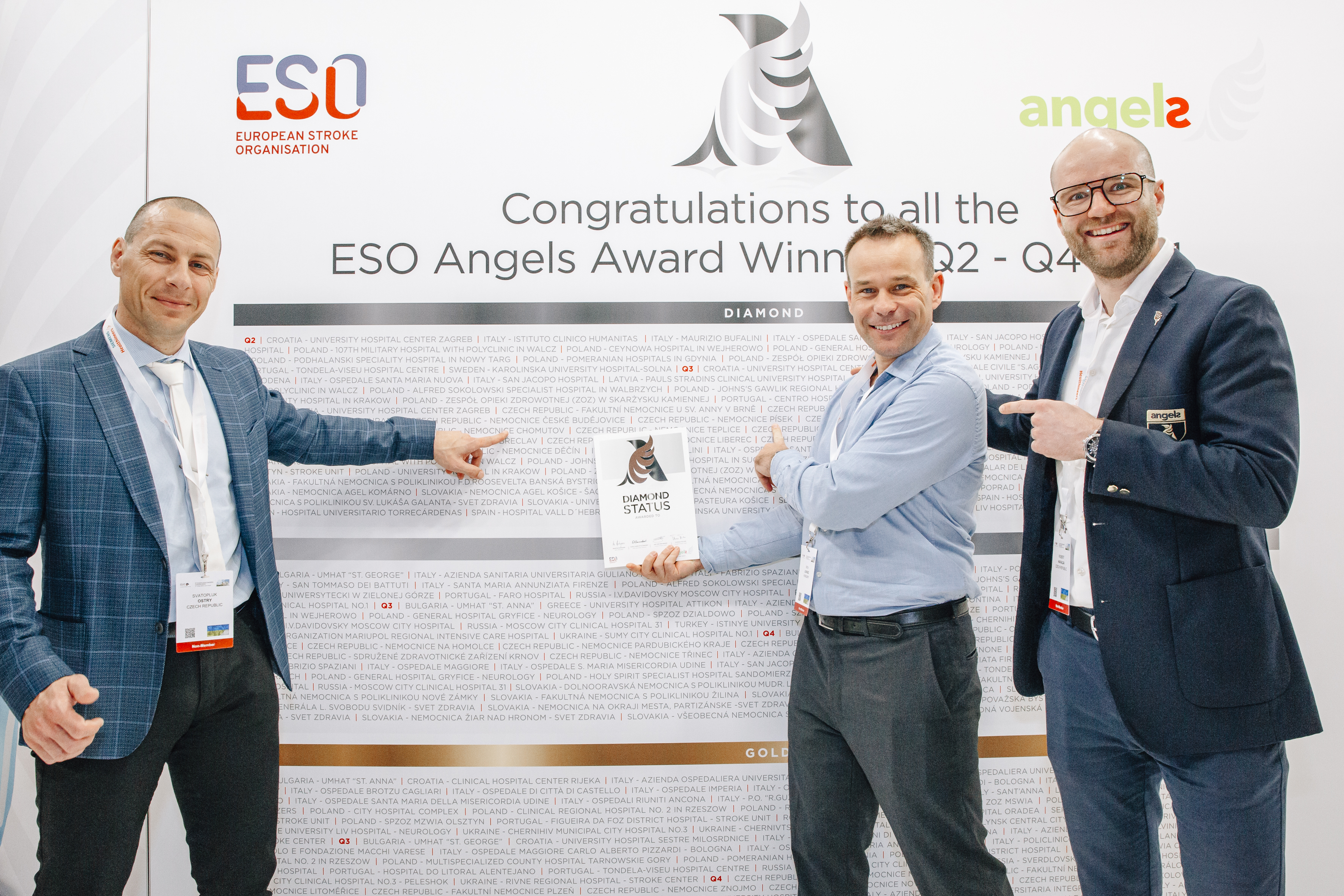
Notre coopération est maintenant parfaite
Les choses sont très différentes et bien meilleures, si vous voulez la vue du Dr Robert Rezek, médecin principal de l’unité neuro-vasculaire de l’hôpital Pàsek, un centre principal situé dans la ville de Pàsek à environ 45 minutes au nord-ouest de l’hôpital Budkéjovice. L'hôpital de PÊsek est l'un des 40 hôpitaux diamant de la République tchèque, distinction qu'il a obtenue pour la deuxième fois l'année dernière. Le temps moyen du DTN est de 17 minutes en première intention.
Lorsque le Dr Rezek est venu de Prague il y a environ 13 ans, un système de soins neuro-vasculaires était déjà en place, mais il suivait l’intervention du Dr Ostré à l’hôpital Budkéjovice selon laquelle la coopération avec ce centre s’est améliorée et les patients AVC de la région pouvaient recevoir des soins complets de haut niveau, explique-t-il.
"Auparavant, nous n'avions pas pu fournir de soins de qualité aux patients présentant une occlusion des gros vaisseaux. Cependant, depuis 2013, l’ensemble de l’équipe spécialiste de l’accident vasculaire cérébral de Budëjovice a changé et maintenant notre coopération est parfaite et le taux de trombectomie mécanique a considérablement augmenté.
La coopération parfaite entre les centres primaires et complets repose sur un service d’ambulance bien formé, non seulement capable de transférer les patients entre les centres aussi efficacement que possible, mais aussi capable de sélectionner le bon patient pour le bon hôpital.
Le Dr Rezek souligne que former les ambulanciers améliore tout le système. À cette fin, il est devenu lui-même étudiant à l’automne 2022 lorsqu’il a rejoint un atelier de formation avancé de réanimation après un accident vasculaire cérébral facilité par Angels à Budapest pour devenir un instructeur ASLS certifié.
"Il est un excellent professeur", dit Martin Liptay, et ses leçons sont populaires auprès des ambulanciers de la région qui reçoivent volontiers les avis d'un médecin leader médecin le domaine de l'accident vasculaire cérébral.
Robert Rezek, 18 ans, a décidé de devenir médecin d'un coup pour "aider les gens et améliorer le monde". Devenir neurologue n’était que sa bonne chance, explique-t-il, une séquence de coïncidences chanceuses qui l’ont amené de Prague à PÊsek pour aider cet hôpital à améliorer son programme de soins neuro-vasculaires et à développer la Bohémie du Sud comme lieu sûr pour l’accident vasculaire cérébral.
Le Dr Rezek explique que travailler en dehors d’une grande ville comme Prague implique un plus grand fardeau de responsabilité. "A Prague on peut compter sur les autres pour aider, mais ici dans notre région on doit prendre soin des patients nous-mêmes." Pour cette raison, il valorise le sens de la communauté favorisé par Angels, et les opportunités de "partager des luttes et des succès avec d'autres hôpitaux et de s'inspirer mutuellement".
Sa première priorité après son arrivée dans cette ville historique à cheval sur la rivière Otava était de changer la logistique des patients, explique le Dr Rezek. "Précédemment, l'équipe a rencontré le patient en ambulance et un examen clinique a été réalisé avant le transfert du patient en salle de TDM. Cela a pris du temps. Maintenant, avec une meilleure sélection par les ambulanciers, nous sommes prêts pour le patient avant son arrivée et nous les recevons en salle de TDM. On fait d'abord le scan, avant l'examen physique, et on n'attend pas les résultats de laboratoire avant de commencer la recanalisation".
Enfin, le traitement du patient à la TDM permet de réduire les délais entre l’arrivée et la perfusion.
Un grand pas en avant dans la médecine de l’accident vasculaire cérébral
"Transfert des patients directement au TDM a été une étape importante vers la réduction des temps de traitement", explique le Dr Marek Slab, qui, en plus d'être président de l'Association nationale des SMU, est directeur des SMU dans la région du Bohème du Sud et représente le district Tàbor au Sénat de la République tchèque.
La coopération standardisée entre les hôpitaux et les services ambulance a eu un impact significatif sur les temps de traitement, explique le Dr Slab. Il a participé à des discussions conduisant à la formation d’un réseau d’accident vasculaire cérébral en Tchèque, et est satisfait que les handicaps résultant de l’accident vasculaire cérébral diminuent en conséquence. La définition du réseau du centre neuro-vasculaire et la mise en place de règles pour le triage ont été un grand pas en avant dans la médecine de l’accident vasculaire cérébral, explique-t-il.
"Après que les règles pour une communication efficace et un triage vers le bon hôpital ont été convenues avec le centre neuro-vasculaire de Budïjovice, tous les paramètres clés se sont améliorés de manière drastique et le transport des patients vers de petits hôpitaux non traitants a été presque complètement éliminé. La connaissance de la terminologie appropriée a également aidé les ambulanciers à communiquer plus efficacement avec les centres d’accident vasculaire cérébral.
Les prix des SMU ont également eu un impact positif sur la qualité des soins pré-hospitaliers pour accident vasculaire cérébral grâce aux commentaires tirés de la collecte et de l’évaluation des données des patient. "Il est important que les gens voient ce qu'ils font qui importe", dit le Dr Slabé.
Les SMU de la région du Bohème du Sud, qui ont remporté trois prix platine et un prix diamant, ont été fondés en 2005 et, après près de deux décennies au poste de directeur, le Dr Slab à compter sur une équipe solide pour le soulager des tâches quotidiennes. Cependant, il a conclu un accord avec le responsable politique de la région selon lequel il quittera l’entreprise et travaillera en tant que médecin habituel des SMU si ses autres responsabilités devenaient trop lourdes. Il maîtrise cependant l’art de passer d’un poste à l’autre et trouve que son expérience en tant que politicien lui permet de mieux comprendre les liens entre la santé et les problèmes sociaux.
Il a également été en mesure d’influencer les discussions sur la collaboration transfrontalière, ce qui, selon lui, est très important pour les patients. "En raison du tourisme, du travail transfrontalier et des navettes transfrontalières, par exemple pour faire les courses, il est essentiel de communiquer et de collaborer", dit le Dr Slabé. Des accords sont déjà en place avec l’Allemagne et l’Autriche, et il existe également des accords entre des régions individuelles telles que la Bohémie du Sud et la Haute Autriche, dont les citoyens, comme le Dr Kulyk l’a souligné, sont à l’affût des mêmes montagnes et vallées.
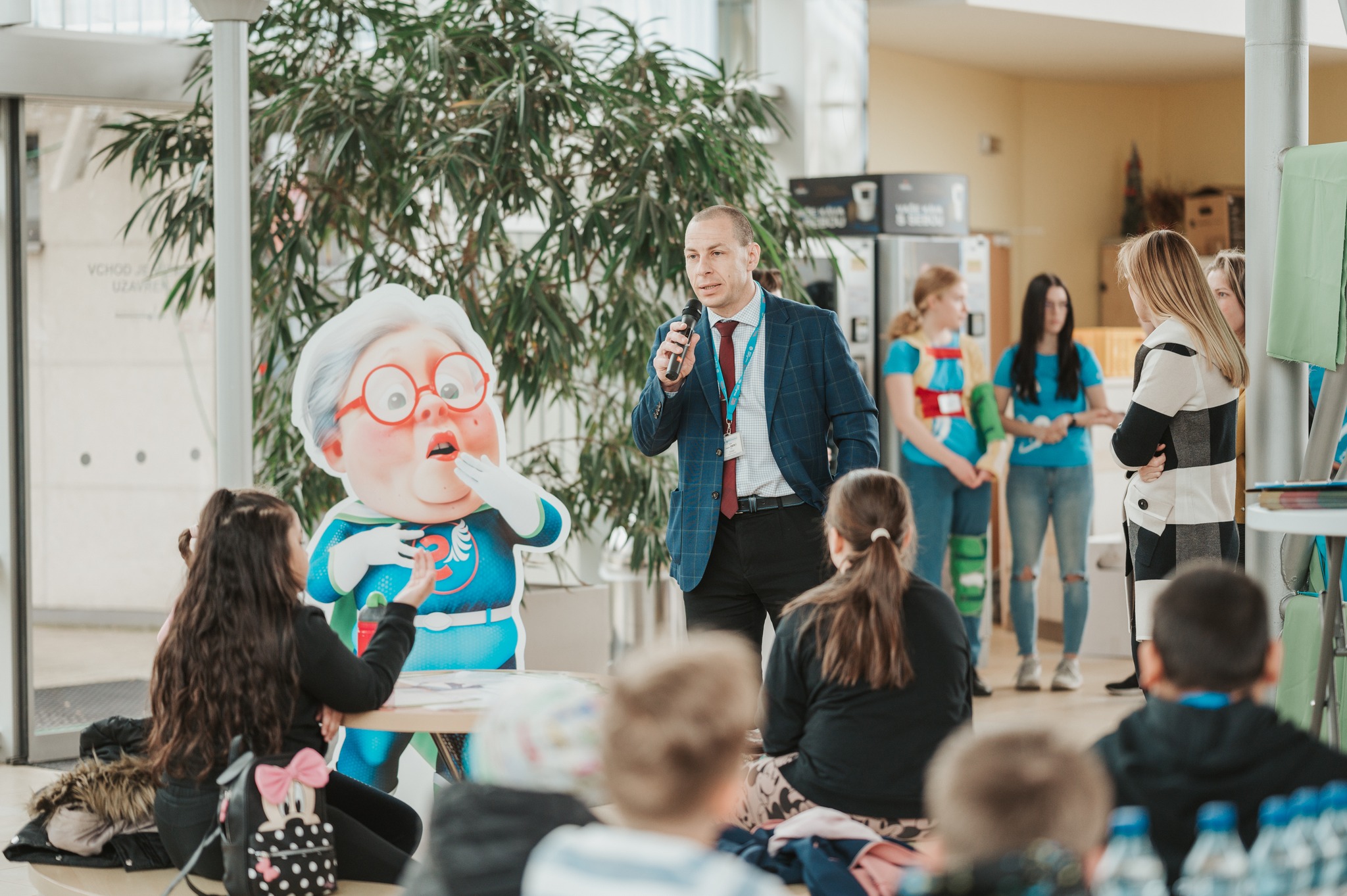
Points de comparaison
"La formation continue de notre personnel ambulancier est essentielle", explique le Dr Kulyk. Outre son point de vue sur l’état d’esprit des patients arrivant et l’utilisation de chronomètres en phase hyperaiguë pour rappeler que l’heure est le cerveau, elle a l’intention de suivre l’exemple des Dr Ostr à Rezek et de hiérarchiser la formation sur l’AVC pour les ambulanciers.
"Après optimisation du triage pré-hospitalier, rencontrer les patients directement au scanner TDM serait la prochaine étape pour raccourcir le délai d’attente avant la prise en chargeelle. "En ce moment, nous estimons que les patients ont encore besoin d'un triage aux urgence urgences pour exclure les ressemblances d'accident vasculaire cérébral.
Nous utilisons également cette première évaluation à l’hôpital pour décider si les patients doivent être envoyés à la TDM ou à l’IRM. Nos protocoles d’IRM d’accident vasculaire cérébral aigu sont courts (10 minutes) mais prennent encore plus de temps que la réalisation d’une TDM. Le défi c'est de trouver un milieu doré entre très rapide et très précis".
Concrètement que tous les processus ne peuvent pas être transférés vers un autre site sans s’adapter aux conditions, le Dr Ostr à tout moment maintient que les principales étapes peuvent être copiées dans le cadre d’une amélioration avérée.
"Nous sommes fiers d'être un exemple pour les autres et nous avons été très heureux de leur montrer comment il est possible de le faire", dit-il. Mais la collaboration transfrontalière est un effet secondaire, et l’augmentation de la norme de soins dans la Bohémie du Sud reste l’objectif principal. À cette fin, il est également membre du comité de direction Angels et ambassadeur de la campagne de sensibilisation FAST Heroes dans la région.
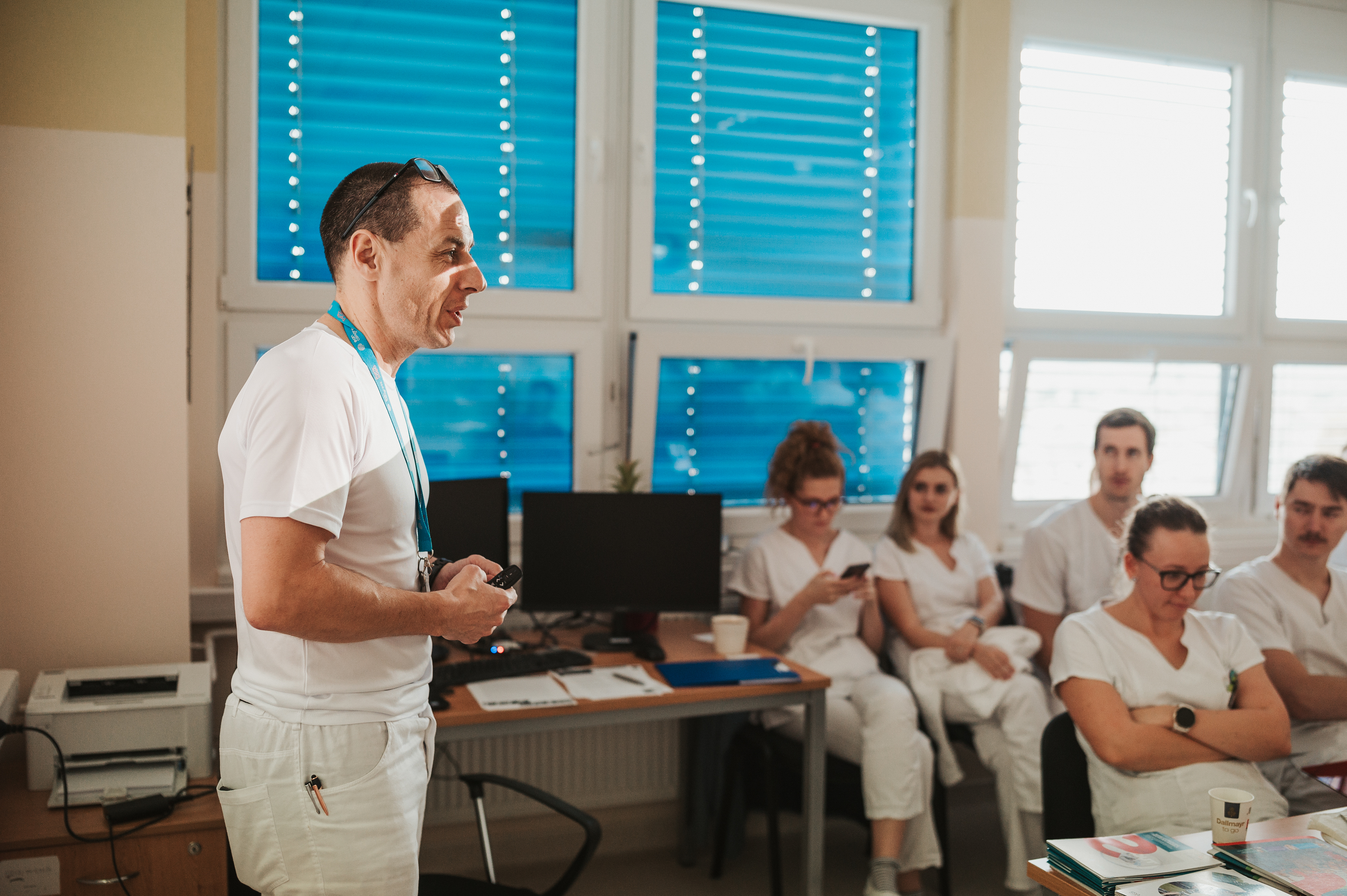
Faire preuve d’empathie
Le Dr Ostrà a grandi dans le nord de la Moravie, dans l’est de la République tchèque, et a fréquenté une école où l’accent était mis sur les mathématiques et la science. La plupart de ses camarades d’école ont étudié l’économie, les mathématiques et la physique ; Svatopluk Ostr est l’un des rares à avoir choisi la médecine comme leur carrière. Il était principalement attiré par le potentiel d’appliquer des règles à la vie réelle et d’utiliser ses connaissances pour avoir un impact sur la vie des autres, explique-t-il.
La neurochirurgie offrait la possibilité d’un argument logique, d’une prise de décision rapide et d’une action directe, et il a trouvé des caractéristiques similaires dans la prise en soins neuro-vasculaires. "Il faut décider s'il faut traiter ou non et quelle façon traiter", dit-il. Ce qui le rend encore plus intéressant, c’est que, même avec des directives, une zone grise reste, de sorte que vous ne pouvez pas, dans tous les cas, être absolument certain de la meilleure option.
Les recherches du Dr Ostr sont axées sur la mise en œuvre de la neurophysiologie dans le processus diagnostique dans l'accident vasculaire cérébral aigu et l'exploration d'une troisième option pour traiter l'accident vasculaire cérébral ischémique aigu, à savoir l'élimination des caillots par microchirurgie dans les cas où la thrombectomie mécanique a échoué. Ses pratiques antérieures en neurochirurgie et neurophysiologie sont en jeu alors qu’il fait équipe avec son collègue de l’hôpital Budké-Jövice, neurochirurgien de renom, le Dr Jicha Fiedler, entre autres choses pour développer un protocole pour l’élimination des caillots dans le cadre d’une intervention intracrânienne. Leurs résultats communs ont attiré l'attention du monde entier sur le travail révolutionnaire réalisé dans leur hôpital.
Il est important de préciser que l’hôpital est un aimant pour ceux qui recherchent un développement professionnel dans une région où les médecins tels que les Drs Ostr, Rezek et Slaba sont des leaders dans tous les aspects des soins de l’AVC. Ils vont bientôt être rejoints par l’hôpital Jindàichyv Hradec, un centre d’centre neuro-vasculaire nouvellement certifié dans une autre ville historique située à environ 42 km au nord-est de la Êeské Budkyjovice.
Sous l’aile du Dr Ostr, les futurs médecins spécialistes de l’AVC peuvent s’attendre à une croissance plus que professionnelle : l’accent est également mis sur le développement personnel. L'idée est de nourrir la capacité d'empathie et la capacité à considérer les problèmes du point de vue des autres, explique le Dr Ostr.
"Nous ne sommes pas tous les mêmes et cela soulève le potentiel de malentendu. Nous pouvons tous avoir le même problème, mais le considérer de différents points de vue. La hiérarchie de chacun de ce qui est important est différente, et pour travailler ensemble il faut savoir ce que les autres considèrent comme moins ou plus important pour mieux les comprendre".
C’est aussi la façon dont vous devenez le meilleur.
